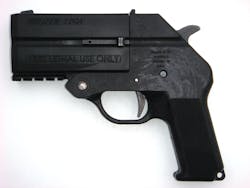A couple years back Tommy Teach of Elkhart, Indiana, found himself sharing the road with a very agitated driver. As the situation escalated, it became clear the enraged individual was not about to simply move on down the road … so Teach took action. He promptly called area police and identified himself.
“The guy was on meth; he was a tweaker,” recalls Teach. “I pulled over in an effort to diffuse the situation, but the guy pulled over behind me and I could not get back out into traffic.”
Police could not get to the scene quickly enough as the other individual exited his car and approached Teach, so the military combat veteran reached for his concealed weapon.
“I pulled my weapon and took aim; the guy looked up when he was about ten feet from me and finally laid down on the ground. I had to protect myself, but I thought there has to be a better way to do it.”
A twist on 12
Concealed carry laws are in a constant state of metamorphosis in this country. One day they’re in, the next they’re out. Some states also limit or prevent civilian use of electronic controlled devices.
“As of February 2011 in D.C., Hawaii, Massachusetts, Michigan, New Jersey, New York, Rhode Island, Wisconsin, (parts of) the U.S. Virgin Islands and Indiana civilians are not allowed to have [an ECD] for self-defense,” says Teach. Enter the Bruzer – a less lethal launcher. “Because you can’t always get to a shotgun,” says Teach. After dealing with various local police departments, Teach and his team noticed a void between common ECDs and 12-gauge shotguns marked ‘less lethal’. The consensus was the 12-gauge isn’t always as portable as it could be.
Teach’s military background no doubt shapes his ideas on the nature of less-lethal tools used in both the military and in a law enforcement capacity. Teach and his business partner, David Sult, run the company Bruzer Less Lethal, in Elkhart, Indiana. Here they produce the patent-pending compact 12-gauge less lethal launcher (the Bruzer) that uses an array of off-the-shelf less lethal ammunition. The compact, orange- or black-barreled launcher made its debut at the annual International Association of Chiefs of Police (IACP) in Chicago last October.
“We have a number of concerning things going on in the world today,” Says Teach. “We have a lot of civil unrest. When a person faces the Bruzer head-on – and we don’t actually recommend that you do this – they will see two very large diameter barrels staring back at them. It’s a big deterrent. People are going to look at this and [say] wait a minute, this doesn’t look good. And chances are … they are going to stop whatever they’re doing.”
The fact that the one hundred percent U.S.-made Bruzer looks so strikingly similar to its lethal cousin is no accident. The lightweight device can be drawn from a leg rig, vest-mount or cross-draw holster. It is a versatile option for officers, and very intimidating to whoever happens to be on the other end. The two-shot launcher is simple to maintain and does not require chargers or batteries; it operates like a gun and has a multiple shot capacity. Users can easily change out the munitions based on their unique situation, using things like kinetic energy impact munitions, chemical delivery, flash bang ordinance and flare/signaling. An ALS rubber-finned rocket can reach distances of 50 feet. For those officers who find themselves in close quarters situations (think corrections), Teach says Lightfield Less Lethal’s star rounds and West Coast Ammunition’s Accusox bean bag munitions have been shown to be the most successful.
Teach notes, “Over the course of four years of research and development we’ve tested a wide variety of less-lethal munitions and found that these particular products perform well with this model of launcher.”
The company also offers accessories like Kydex hosters (manufactured by Holsters Plus) for a Molle vest, a drop belt or a drop leg rig, in addition to offering the appropriate ammunition and training courses for operators and instructors in the military, law enforcement and private security firms.
Cruising for a brusing?
Neuromuscular interrupters will case subjects to lose control of their muscles. Individuals struck by the Bruzer will not go rigid, but they will feel pain. “We never recommend that you shoot at the upper thoracic cavity,” says Teach. (Always consult your department’s standard operating procedures and target area chart.) “The objective is to inflict sufficient pain to gain compliance. For example, you might encounter a threatening suspect with a knife. Do we need to kill that person? Not necessarily.” The Bruzer can be used in areas and situations where lethal munitions would cause extensive damage to the subject, and even to surrounding persons and property. Plus, its impressive shooting distance of up to 50 feet, depending on the munitions deployed, allows a judicious space to be maintained between officer and suspect.
Optional high visibility orange barrels are available and can be used to indicate the Bruzer is indeed a less lethal weapon. Law enforcement officers can decide whether they want the orange barrels or black. Teach says that while it’s a personal preference, SWAT teams performing tactical entries or breaching have reported that they typically prefer the black, while patrol officers on the street might gravitate to the orange for east of visual identification. The single-action design adds a greater degree of caution on the part of the operator, as the time require to re-cock the launcher between shots provides a moment to re-assess the situation before deciding to fire again.
Down the road, Teach says they are looking to implement a few safety features which will prevent a lethal 12-gauge shell from inadvertently being inserted into the launcher. “We’ll actually change a part out in the gun … so you have no cross-contamination. You can try to fire it, but the launcher won’t operate.” If users wish to purchase the Bruzer now, the company will send this upgrade free of charge when it becomes available.
The third option
“Through my military experience and work with law enforcement, I’ve learned that people at their core don’t want to kill each other – they’re forced to,” laments Teach. Perhaps that is one of the key reasons why the Bruzer has been so well-received not only by law enforcement agencies, but also by civilians looking for another means of personal protection. It gives them an option to potentially both mitigate a dangerous situation and not kill another human being.
Law enforcement officers today have a difficult task at hand. They also have wide array of lethal weapons and less lethal tools to choose from. The Bruzer was designed to fill in the gaps. When you’re talking about using tools on the job that can deter, debilitate or even kill another person sometimes less really is more.

Sara Scullin
Sara Scullin was the Editor of Law Enforcement Technology magazine, a monthly business-to-business publication that covers technology trends and best practices for public safety managers. LET is part of SouthComm Law Enforcement Media, which also publishes Law Enforcement Product News and Officer.com. Sara had covered the law enforcement industry since March 2008.



